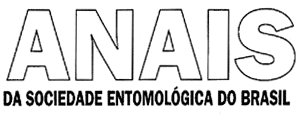De adultos de Megalotomus parvus West. coletados durante agosto-novembro de 1995 em guandu, Cajanus cajan e lablab, Dolichos lablab (Leguminosae) na fazenda experimental do Centro Nacional de Pesquisa de Soja, Londrina, PR., obtiveram-se adultos de taquinídeos pertencentes a três gêneros diferentes: Hyalomyia sp., Hyalomyodes sp., e Trichopoda sp., os quais estão depositados na coleção de insetos do Centro Nacional de Pesquisa de Soja, Londrina, PR. A incidência do parasitismo foi ocasional, confirmando os escassos dados na literatura de ser o parasitismo por Tachinidae em percevejos Alydidae um fato raro.
Insecta; Diptera; Tachinidae; inimigos naturais; percevejo
Insecta; Diptera; Tachinidae; inimigos naturais; percevejo
Insecta; Diptera; Tachinidae; inimigos naturais; percevejo
SCIENTIFIC NOTE
Tachinid parasites of adult Megalotomus parvus West. (Hemiptera: Alydidae)
Taquinídeos parasitas de adultos de Megalotomus parvus West. (Heteroptera: Alydidae)
Claudia H. SantosI; Antônio R. PanizziII
IDepartamento de Zoologia, Universidade Federal do Paraná, Caixa postal 19020, 81531-990, Curitiba, PR
IICentro Nacional de Pesquisa de Soja, Embrapa, Caixa postal 231, 86001-970, Londrina, PR
RESUMO
De adultos de Megalotomus parvus West. coletados durante agosto-novembro de 1995 em guandu, Cajanus cajan e lablab, Dolichos lablab (Leguminosae) na fazenda experimental do Centro Nacional de Pesquisa de Soja, Londrina, PR., obtiveram-se adultos de taquinídeos pertencentes a três gêneros diferentes: Hyalomyia sp., Hyalomyodes sp., e Trichopoda sp., os quais estão depositados na coleção de insetos do Centro Nacional de Pesquisa de Soja, Londrina, PR. A incidência do parasitismo foi ocasional, confirmando os escassos dados na literatura de ser o parasitismo por Tachinidae em percevejos Alydidae um fato raro.
Palavras-chave: Insecta, Diptera, Tachinidae, inimigos naturais, percevejo.
The neotropical Megalotomus parvus West. is common in Brazil, associated mainly with legumes such as soybean, Glycine max (Massariol et al. 1979, Panizzi 1988), common bean, Phaseolus vulgaris (Paradela Fº. et al. 1972, Chandler 1984, 1989), pigeon pea, Cajanus cajan, and lablab, Dolichos lablab (Santos 1996). Despite the abundance and importance of M. parvus as a pest of legumes, very few data are found in the literature on its biology.
During August-November 1995, while colecting M. parvus adults in the field on pigeon pea and lablab plants at the Empresa Brasileira de Pesquisa Agropecuária (Embrapa) Field Research Station at northern Paraná, Londrina County (latitude 23° 11´ S, longitude 51° 11´ W ), five adults with tachinid eggs on their body were obtained. These parasitized insects were taken to the laboratory (25 ± 1°C, 60 ± 5% RH, and 14 hL : 10 hD photoperiod) and put in plastic boxes (12.0 x 12.0 x 3.8 cm) lined with filter paper. Food (air-dried seeds of pigeon pea) and water (plastic lid with wet cotton) were provided.
Tachinid larvae exited from the M. parvus adults, but were unable to pupate. From additional adults collected in the field with tachinid eggs on their body surface and taken to the laboratory, 11 pupae were obtained. From those, three adult flies of three different genera were obtained: Hyalomyia sp., Hyalomyodes sp., and Trichopoda sp., which are deposited in the insect collection at the Centro Nacional de Pesquisa de Soja, Londrina, PR.
We know only two other reports of tachinids parasitizing alydid bugs: Dionaea magnifrons (Herting), parasite of Riptortus clavatus (Thunberg) in Japan (Satoshi Nakamura, personal communication to ARP); and Trichopoda pennipes (Fab.), parasite of Alydus eurinus (Say) in Florida, USA (Buschman and Whitcomb 1980). Apparently, alydids are not suitable hosts for tachinids because of their relatively small body size compared to preferred hosts such as Pentatomidae (Arnaud 1978). Presumably the alydids' small body size did not allow normal development of the fly in our collections (of 11 pupae only three emerged as adults). When small pentatomids are parasitized, adult tachinids smaller in size than usual are obtained (Panizzi and Slansky 1985). Also, alydids are, in general, more restless and, when disturbed, fly quicker than pentatomids, thus perhaps avoiding egg-laying by female tachinid flies.
Acknowledgments
We thank Ronaldo Toma, Departamento de Zoologia, Universidade Federal do Paraná, Curitiba, for the identification of the flies, and C.W. Schaefer for critical reading of this note. This is a contribution of Embrapa Soja number 011/97, published with the approval of the technical director.
Literature Cited
Received 03/IV/97. Accepted 16/IX/97.
References
- Arnaud, Jr., P.H. 1978. A host-parasite catalogue of North American Tachinidae (Diptera). USDA Misc. Publ. 1319, 860 p.
- Buschman, L.L. and W.H. Whitcomb. 1980. Parasites of Nezara viridula (Hemiptera: Pentatomidae) and other Hemiptera in Florida. Florida Entomol. 63: 154-162.
- Chandler, L. 1984. Crop life table studies of the pests of beans (Phaseolus vulgaris L.) at Goiânia, Goiás. Rev. Ceres 31: 284-298.
- Chandler, L. 1989. The broad-headed bug, Megalotomus parvus (Westwood), (Hemiptera: Alydidae), a dry season pest of beans in Brazil. Annu. Rep. Bean Improv. Coop. 32: 84-85.
- Massariol, A.A., Z.A. Ramiro and G. Calcagnolo. 1979. Insetos observados na cultura da soja no Estado de São Paulo. O Biológico 45: 83-88.
- Panizzi, A.R. 1988. Biology of Megalotomus parvus (Hemiptera: Alydidae) on selected leguminous food plants. Insect Sci. Applic. 9: 279-285.
- Panizzi, A.R. and F. Slansky, Jr. 1985. Piezodorus guildinii (Hemiptera: Pentatomidae): An unusual host of the tachinid Trichopoda pennipes Florida Entomol. 68: 485-486.
- Paradela Fº, O., C.J. Rosseto and A.S. Pompeu. 1972. Megalotomus parvus Westwood (Hemiptera: Alydidae), vector de Nematospora coryli Peglion em feijoeiro. Bragantia 31: 5-10.
- Santos, C.H. 1996. Desempenho de Megalotomus parvus Westwood (Heteroptera: Alydidae) em plantas hospedeiras e danos à soja, Glycine max (L.) Merrill. Tese de mestrado, Universidade Federal do Paraná, Curitiba, 85 p.

 Tachinid parasites of adult Megalotomus parvus West. (Hemiptera: Alydidae)
Tachinid parasites of adult Megalotomus parvus West. (Hemiptera: Alydidae)
